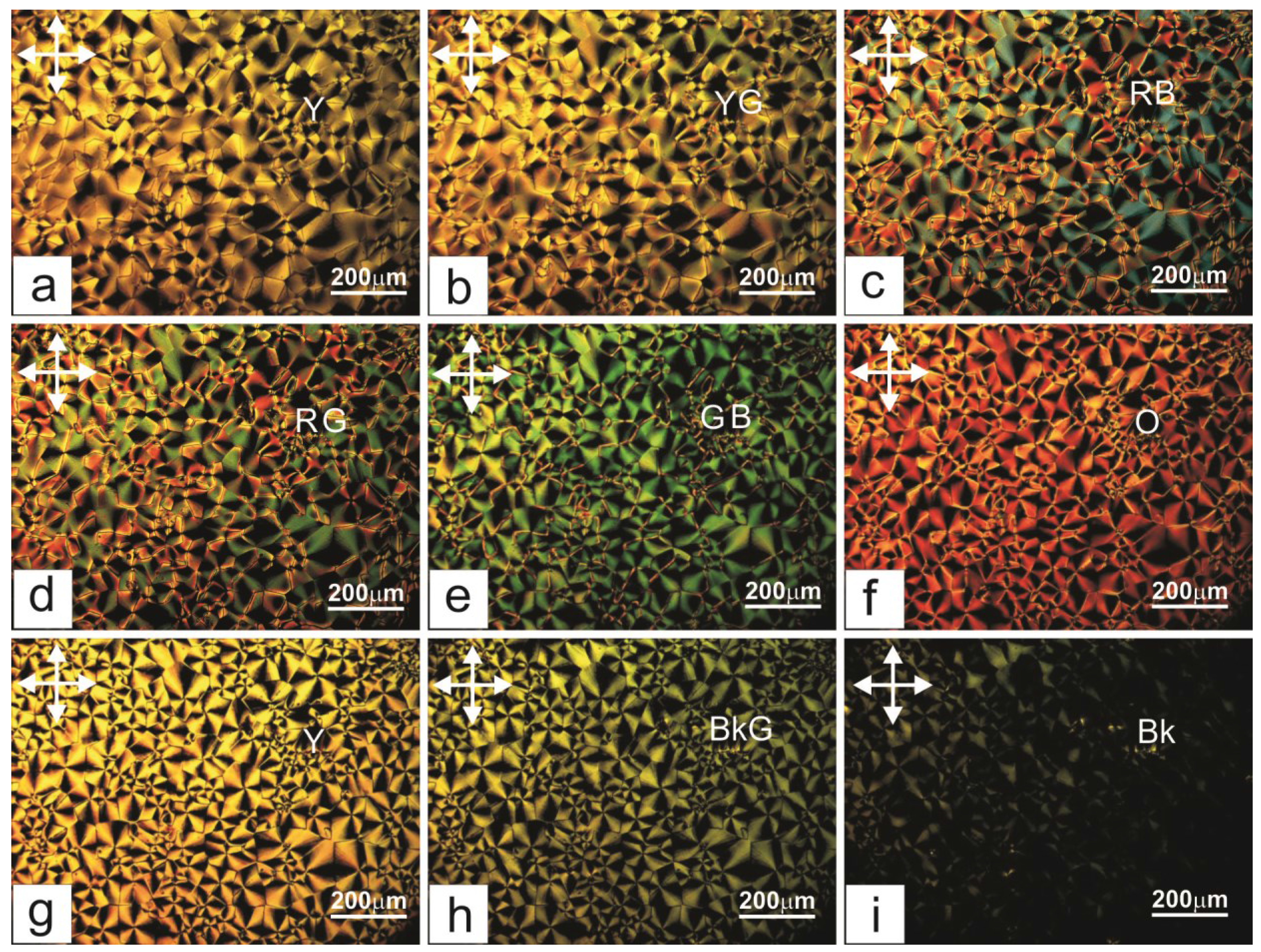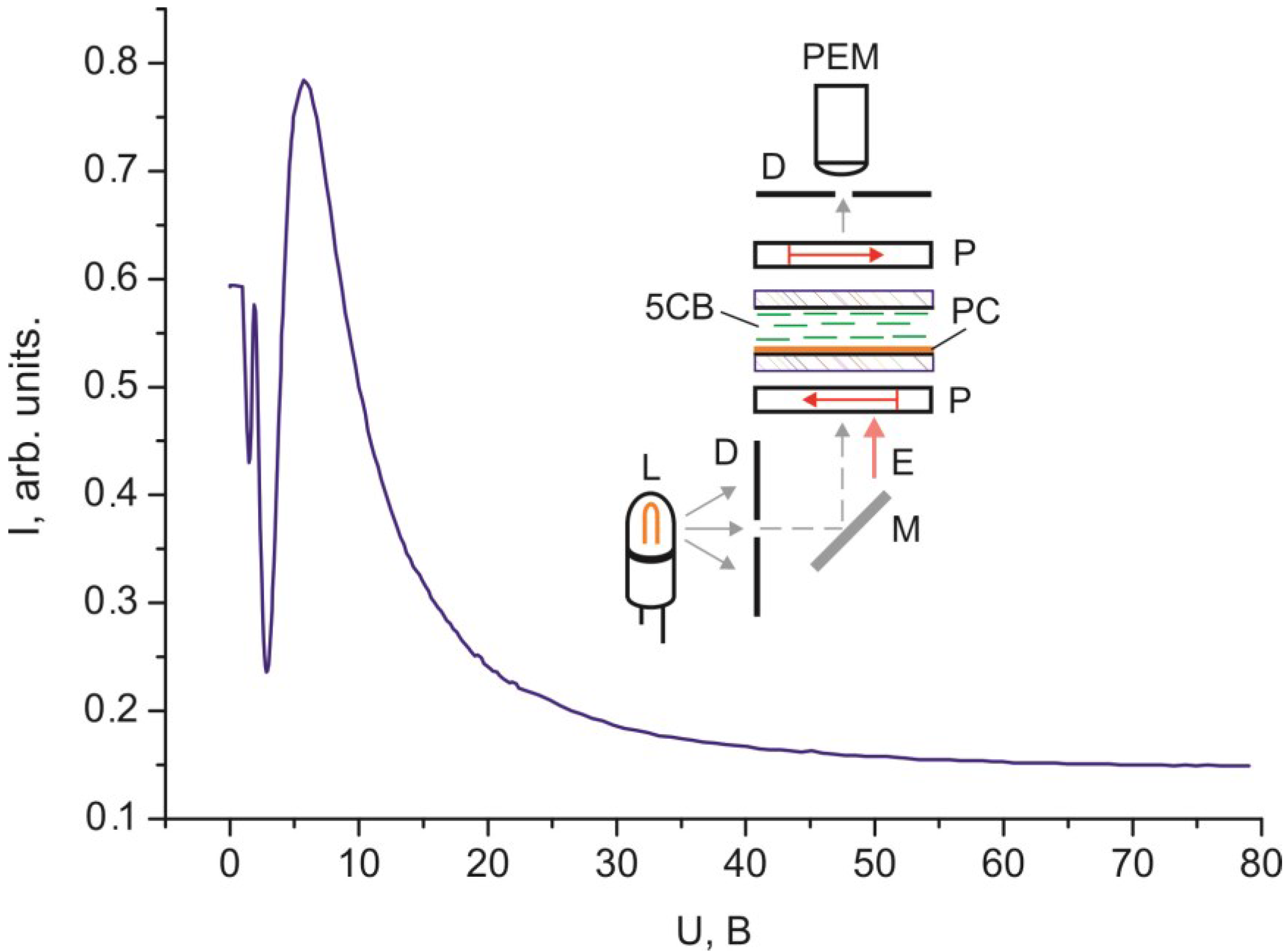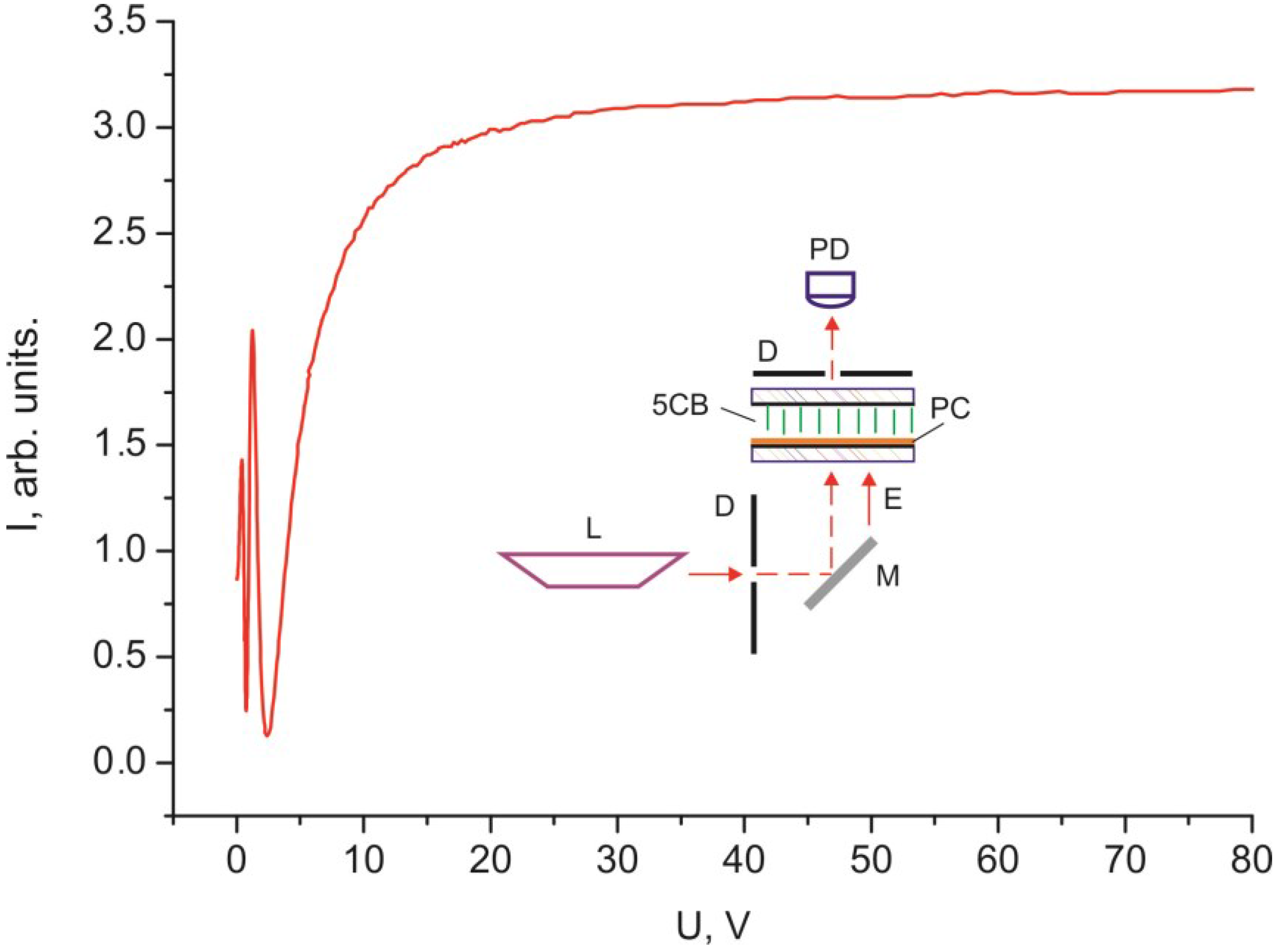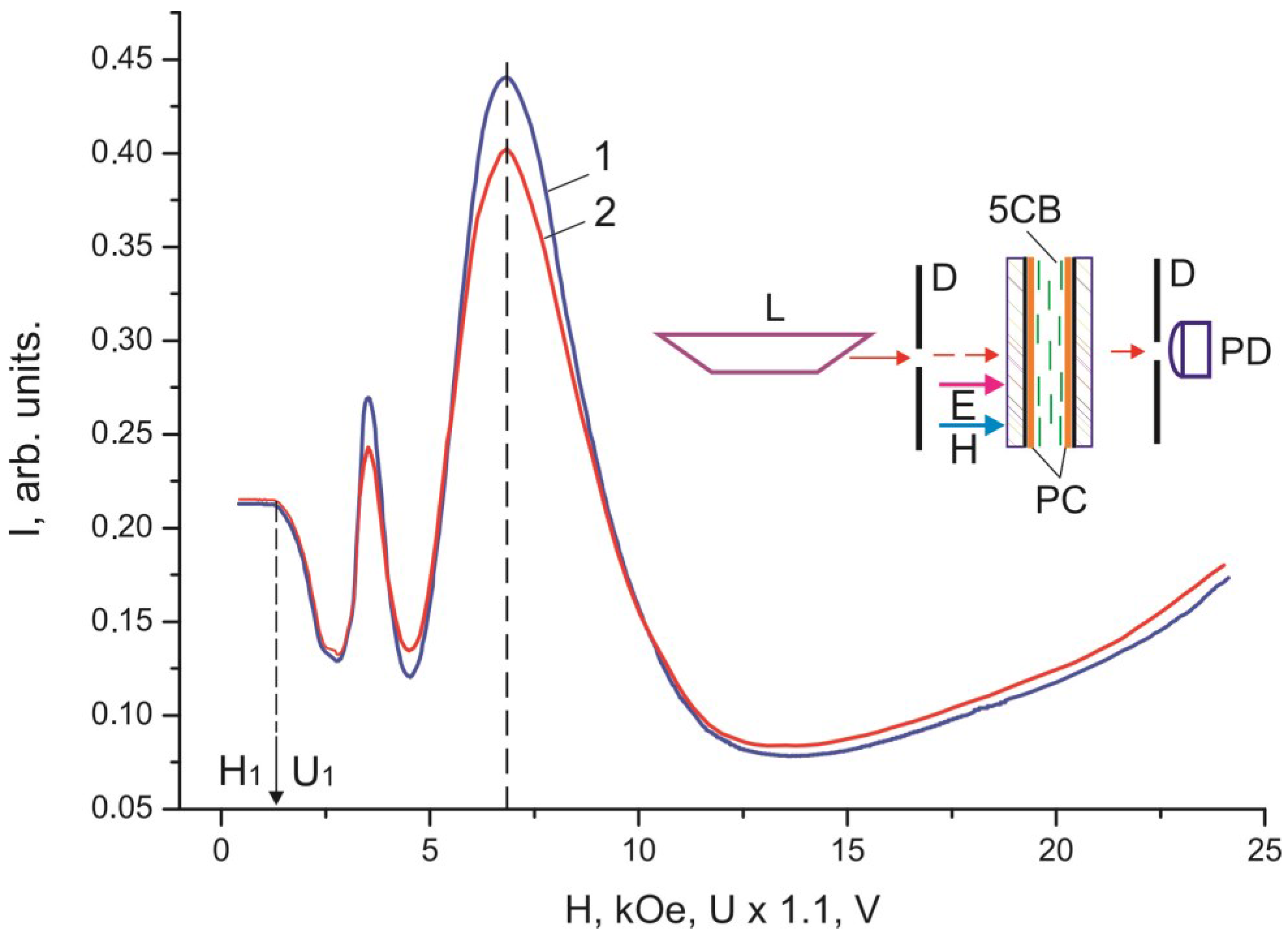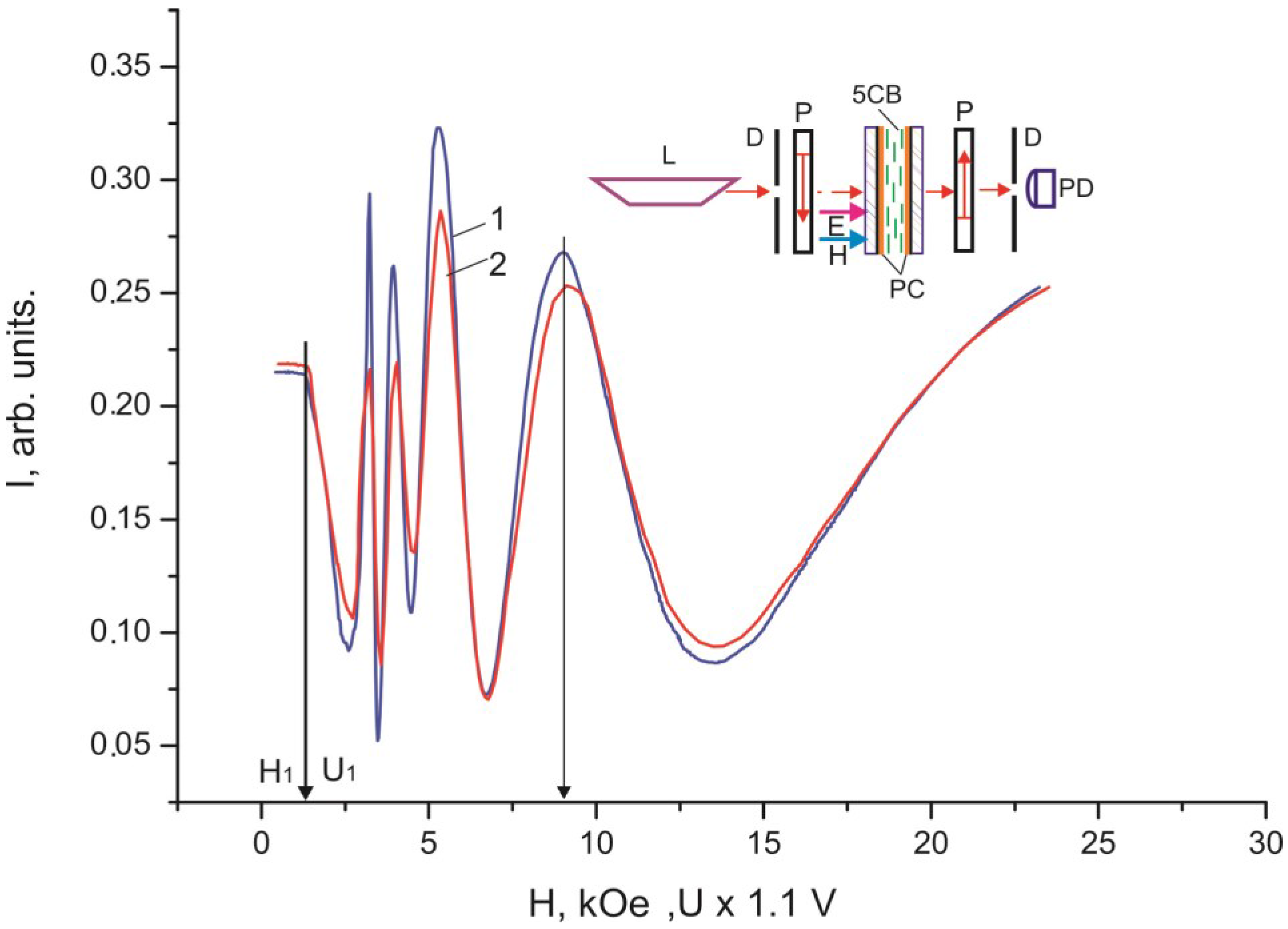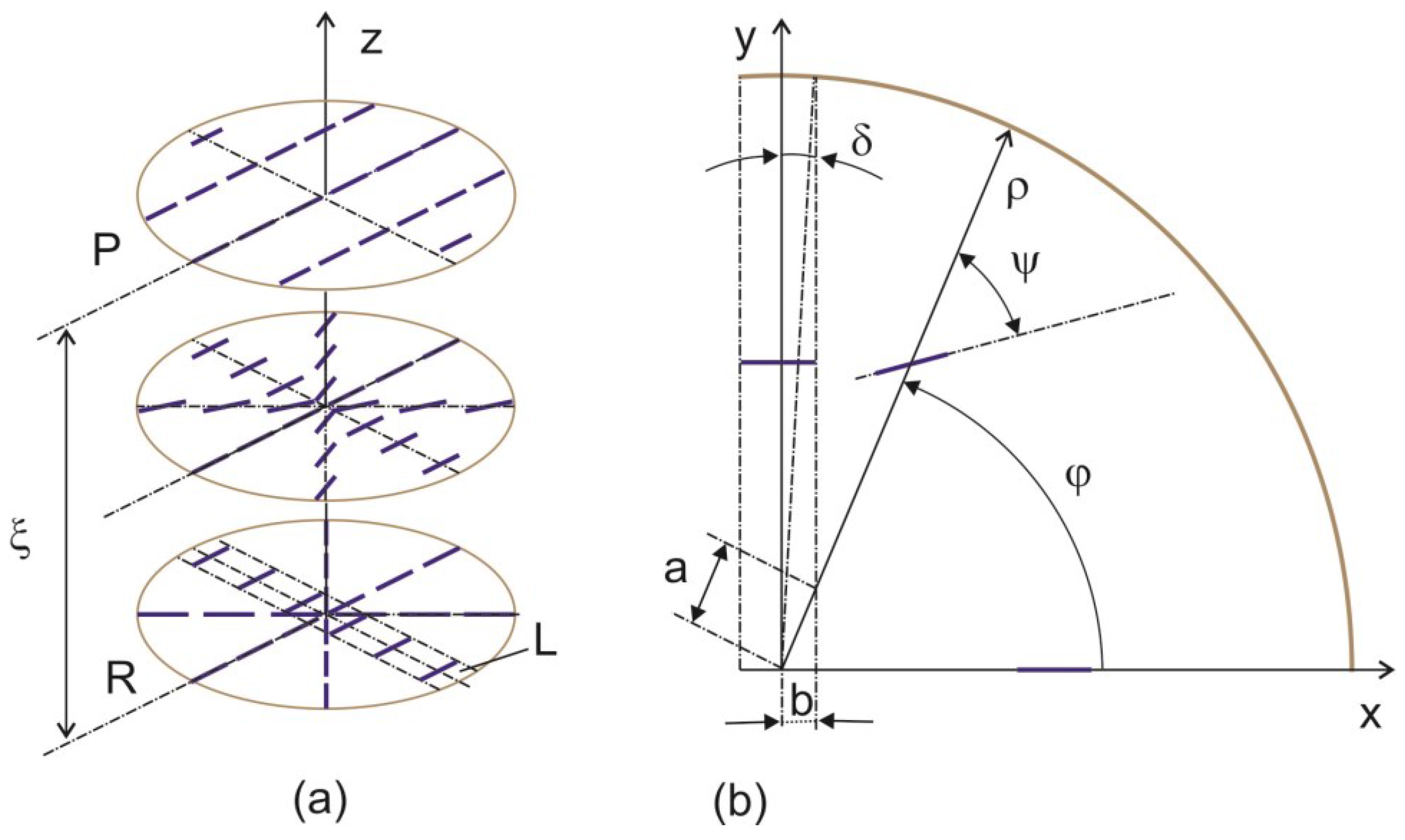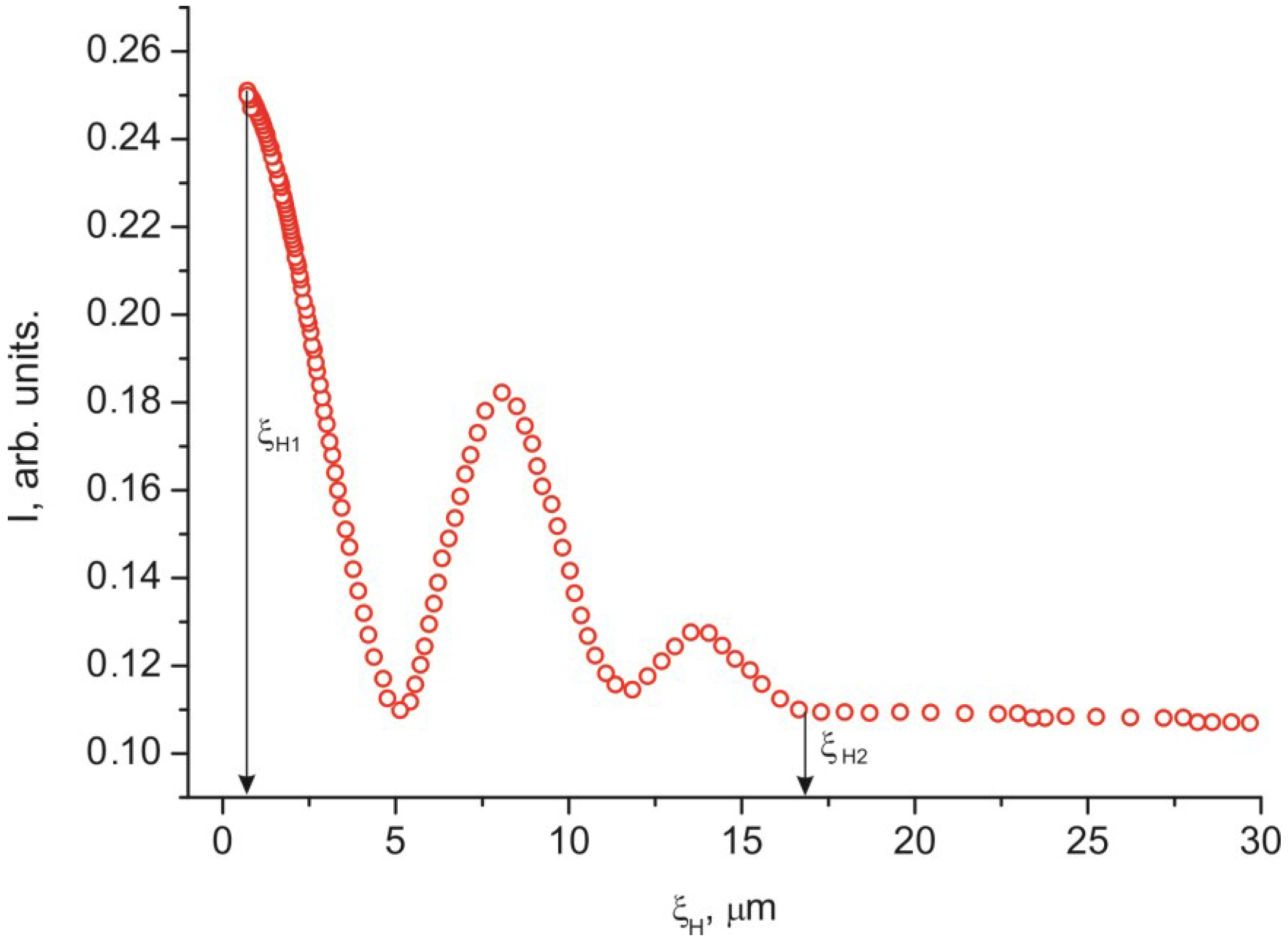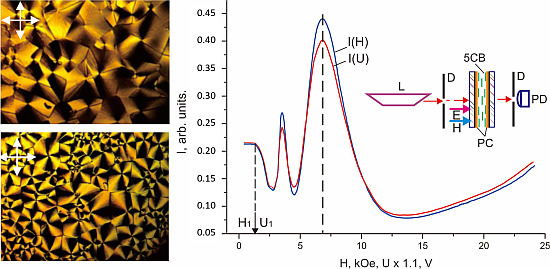3.1. Director Field Distribution in the Liquid Crystal (LC) Layers on the Polycarbonate (PC) Surface
As was established in [
15], the network of radial domains arises on the PC surface. The diameter of each domain is crossed by surface element
L that tends to align perpendicularly to the director of the bulk nematic layer during the domain growth and can retain uniform planar alignment after the domain formation. We may assume that the structure forming in the investigated objects results from equilibrium between uniform alignment induced by
L and the radial structure (
Figure 7). At certain distance ξ from the surface, the radial structure gradually transforms to uniform alignment, since the latter should have the lower free energy due to the absence of strains. In the middle of
Figure 7a, we present the LC molecule distribution in the transition layer of a domain.
We write the LC free energy of director
n in volume
V in the approximation of equal elastic constants
K as [
1].
Figure 7.
(a) Distribution of nematic director field n at the transformation of the radial structure to the uniform planar one at distance ξ from the polymer film surface and (b) parameters in the X0Y plane for calculation in cylindrical coordinates.
Figure 7.
(a) Distribution of nematic director field n at the transformation of the radial structure to the uniform planar one at distance ξ from the polymer film surface and (b) parameters in the X0Y plane for calculation in cylindrical coordinates.
In the cylindrical coordinates, the nematic director components are written as
Angle ψ of deviation of molecules from polar radius ρ is zero on the surface (
z = 0, ψ = 0) and ψ = φ at the distance
z = ξ
0 from the surface. We assume ψ = (1 − exp(
z/ξ)·φ, taking into account the exponential weakening of the aligning effect of the surface at large distances [
1]. Substituting director field distribution (2) in expression (1) and integrating over
l ≤ ρ ≤
R, 0 ≤ φ ≤ 2π − 4δ, and 0 ≤
z ≤ ∞, we obtain
where R is the domain radius, b is the half-width of element L, Fl is the energy of distortion induced by L that contains the angular term calculated with regard to angle δ characterizing the angular size of L and the geometrical term related to the segment a = b/cos φ intercepted by element L from ρ.
Minimizing Equation (3), we obtain the equilibrium length
3.2. Electro- and Magneto-Optical Characteristics
The threshold character of the field dependences of the intensity of light passed through the samples (
Figure 2,
Figure 3,
Figure 4,
Figure 5 and
Figure 6) and the absence of texture variations up to saturation voltages confirm our assumption that the field-assisted director reorientation in the nematic layer occurs without changing the structure of the LC surface domain layer [
15]. It should be noted that determination of the Freedericksz threshold field using a classical technique [
16] yields nonphysical results. In fact, under this assumption, at the constant of splay distortion
K11 = 6.4 × 10
−7 dyne and the dielectric anisotropy Δε = 13.3 [
16], we obtain the calculated value
U1' = π (4·π·
K11/Δε)
1/2 = 0.73 V for infinitely strong anchoring of the LC with surface. The experimental value of the threshold voltage is
U1 = 1.2 V. However,
U1 cannot be greater than
U1' [
17]. This is probably due to strong nonuniformity of the electric field in the LC with the strained transition layer with distance ξ
0. In this situation, it is necessary to take into account additional contributions of the surface layer capacitance in strong electric field
E [
18] and the anisotropy of electric conductivity [
19]. Since these contributions are very complex to be taken into account, we conducted additional experiments in a magnetic field that do not require field nonuniformity corrections. Thus, we established the correspondence between fields
E and
H (
Figure 5 and
Figure 6). It can be seen that the curves
I (
U) and
I (
H) nearly coincide at a normalization constant of 1.1. Therefore, the aligning effects of the electric and magnetic fields can be considered equivalent, so reduced field
H can be used instead of field
E. In this case, the experimental threshold magnetic field is
H1 = 1.1·
U1 = 1.3 kOe, if the bulk LC layer is assumed to be homogeneous. Under this assumption, at the magnetic susceptibility anisotropy constant Δχ = 1.18 × 10
−7 [
20], we obtain the calculated value
H1' = π/
d (
K11/Δχ)
1/2 = 2.4 kOe. The significant difference between
H1' and
H1 indicates that nematic anchoring with the PC surface is weak if polar energy
Wθ used in the estimation is determined using a standard technique [
21]. However, the adsorption of nematic molecules on the surface should cause a strong anchoring.
In addition, as shown in reference [
10], the preferential adsorption of LC molecules on etched glass surfaces leads to the inability to use standard methods for the elastic interpretation of orientation effects. Evidently, the effects of adsorption reduce the voltage amplitude of the electric field with respect to the amplitude of the magnetic field in
Figure 5 and
Figure 6 in the oscillation regions of rapidly changing the orientation of the LC molecules. It is very likely that electrochemical reactions (such as an electron-transfer reaction between PC and 5CB molecules) are in the investigated structures. However, at higher voltage, no deviations of the saturation curves from the exponential
I (
U) dependency were observed.
The discrepancy between the experimentally determined threshold fields Fredericks
U1 and
H1 with the calculated values
U1' and
H1' confirms the unsuitability of the elastic model in the case of interaction of nematic with the PC surface. In this case we use the magnetic coherence length ξ
H [
1] from the experimental dependences
I (
H). We will determine ξ
H by the expression ξ
H = 1/
H (
K/Δχ)
1/2, where
K = (
K11 +
K22 +
K33)/3. Using the constants of torsion
K22 = 3 × 10
−7 dyne [
20] and bend
K33 = 8.6 × 10
−7 dyne distortions [
19], the electric field from
Figure 3, and the correlations between the electric and magnetic fields in
Figure 5 or
Figure 6, we built the dependence
I (ξ
H) (
Figure 8). The value of ξ
H that correspond to threshold voltage
U1 = 1.2 V is ξ
H1 ≈ 17 µm. The value ξ
H2 ≈ 0.3 µm that correspond to voltage
U2 is approximately equal to the He–Ne laser half-wavelength,
i.e., the optical resolution limit. In this sense,
U2 is not a saturation voltage, which could be found by extrapolation of the smoothly varying initial portion of the curve
I (ξ
H) in the figure to the single LC layer.
Figure 8.
Intensity
I of the laser radiation passed through the 30 µm thick planar 5CB layer with domains formed on the PC surface
versus magnetic coherence length ξ
H, obtained from
Figure 3. Lengths ξ
H1 and ξ
H2 correspond to voltages
U1 and
U2 related to the threshold field and limit optical resolution field.
Figure 8.
Intensity
I of the laser radiation passed through the 30 µm thick planar 5CB layer with domains formed on the PC surface
versus magnetic coherence length ξ
H, obtained from
Figure 3. Lengths ξ
H1 and ξ
H2 correspond to voltages
U1 and
U2 related to the threshold field and limit optical resolution field.
Each of the dependences
I (
U) and
I (
H) in
Figure 2,
Figure 3,
Figure 4,
Figure 5 and
Figure 6 contains a periodically varying portion with the light intensity oscillations. As can be seen in
Figure 2, the oscillations occur despite the fact that the light penetrating through the LC layer is not polarized and comprises a set of electromagnetic waves of different wavelengths. Each curve contains two pronounced interference maxima and minima.
Figure 9 presents the dependence
I (ξ
H) built using
Figure 2. In the ξ
H axis, we added the black–yellow color scale obtained in the cell with the thickness δ = 30 µm with two plane-parallel glass surfaces rubbed to form uniform planar alignment of the nematic under the action of a magnetic field perpendicular to the surfaces. Designations a–i of the texture colors in
Figure 1 correspond to the color sequence in the spectra of orders I–III of the homogeneous LC layer. This indicates the unambiguous correlation between the intensity of light passed through the LC layer and the magnetic coherence length. Therefore, we may state that in the bulk of the LC in an external field, the nematic direction changes its planar orientation for a uniform homeotropic one with a gradual decrease in the surface layer thickness.
The light intensity oscillations are caused by interference of light beams during their passage through the light-scattering surface layer. This is indicated by the coinciding optical transmission ranges in
Figure 3 and
Figure 4 in the cells with planar and homeotropic alignment in the bulk of the LC layer. The nature of probe radiation intensity oscillations is different from that of the phase modulation of polarized light caused by birefringence in the nematic layer, since the number of maxima and minima
m in the
I (
H) curve obtained in the white light (
Figure 2) equal
m for nonpolarized light (
Figure 5) and simply doubles in the experiment with the use of crossed polarizes (
Figure 6). The oscillations apparently originate from the azimuth redistribution of the nematic director field from uniform alignment in the bulk to the radial configuration on the PC surface. The mechanism of light intensity oscillations will be investigated in the next study.
Figure 9.
Dependence of intensity
I of white light passed through the 30 µm thick planar 5CB layer with domains formed on the PC surface
versus magnetic coherence length ξ
H obtained using
Figure 2. Indices a–i correspond to
Figure 1a,i. Designations black–yellow in the ξ
H scale correspond to the color sequence in the spectra of orders I–III obtained in an external magnetic field in the planar LC layer in the cell with glass surfaces.
Figure 9.
Dependence of intensity
I of white light passed through the 30 µm thick planar 5CB layer with domains formed on the PC surface
versus magnetic coherence length ξ
H obtained using
Figure 2. Indices a–i correspond to
Figure 1a,i. Designations black–yellow in the ξ
H scale correspond to the color sequence in the spectra of orders I–III obtained in an external magnetic field in the planar LC layer in the cell with glass surfaces.
Thus, our experiments make us draw the following conclusions:
- (i)
The nematic orientation in the LC layer on the PC surface starts changing at a certain threshold electric or magnetic field.
- (ii)
In an external field, the nematic director in the bulk of the LC changes the uniform planar orientation for uniform homeotropic one as the surface layer thickness gradually decreases.
- (iii)
The orientation variations in an external field are accompanied by the light phase modulation, which can be caused by azimuth redistribution of the nematic director field from the uniform orientation in the bulk to the radial configuration on the PC surface.
Figure 10 shows the dependence of free energy
F on distance ξ from the PC surface, which was built using expression (3) and the experimental data
R ≈ 85 µm and
b ≈ 2 µm [
15]. The equilibrium distance ξ
0 ≈17 µm exactly determined using expression (4) coincides with the coherence length ξ
H1 ≈ 17 µm in
Figure 7 and
Figure 8. One may expect that at ξ
H > ξ the director reorientation in the bulk of the LC layer will start at a gradual transition to the homeotropic orientation at ξ > ξ
H.
Figure 10.
Dependence of free energy F on distance ξ from the PC surface. The arrow indicates equilibrium distance ξ0 that corresponds to the free energy minimum at the transition of the LC director field distribution from the radial configuration to uniform alignment in the bulk.
Figure 10.
Dependence of free energy F on distance ξ from the PC surface. The arrow indicates equilibrium distance ξ0 that corresponds to the free energy minimum at the transition of the LC director field distribution from the radial configuration to uniform alignment in the bulk.
